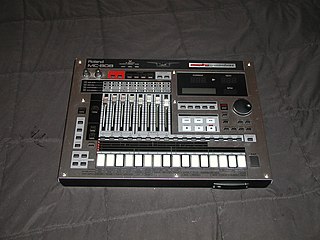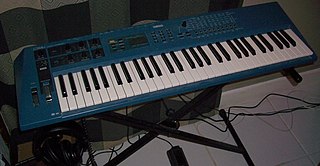
An effects unit or effects pedal is an electronic device that alters the sound of a musical instrument or other audio source through audio signal processing.

A groovebox is a self-contained electronic or digital musical instrument for the production of live, loop-based electronic music with a high degree of user control facilitating improvisation. The term "Groovebox" was originally used by Roland Corporation to refer to its MC-303, released in 1996. The term has since entered general use, and the concept dates back to the Movement Computer Systems Drum Computer in 1981.
Boss is a manufacturer of effects pedals for electric guitar and bass guitar. It is a division of the Roland Corporation, a Japanese manufacturer that specializes in musical equipment and accessories. For many years Boss has manufactured a wide range of products related to effects processing for guitars, including "compact" and "twin" effects pedals, multi-effect pedals, electronic tuners and pedal boards. In more recent times, Boss expanded their product range by including digital studios, rhythm machines, samplers and other electronic music equipment. They also are now manufacturing solid-state amplifiers and speaker heads such as the Waza and the Katana. Both feature multi-effects units meant to emulate Boss' classic effects pedals.

The Roland MC-303 is the first of a series of musical instruments known as a groovebox. It combines a simple sound module with a sequencer to record and store notation, along with controls aimed at encouraging the musician to improvise the music while it is playing. Despite the number in its name and the attention it received at its launch, the MC-303 has more in common with other MC prefixed synthesizers, which contain built-in sequencers, than it does with the famous Roland TB-303. As the first Groovebox, the MC-303 was the first in a line of inexpensive products specifically targeted towards house DJs and amateur home musicians rather than professional producers. It was superseded by the Roland MC-505. It is the predecessor to the Roland JX-305, Roland D2, Roland MC-307, Roland EG-101, Roland MC-09, Roland MC-909, Roland MC-808, and most recently the Roland MC-707 in 2019, along with its more portable sibling, the Roland MC-101.

Novation Digital Music Systems Ltd. is a British musical equipment manufacturer, founded in 1992 by Ian Jannaway and Mark Thompson as Novation Electronic Music Systems. Today the company specializes in MIDI controllers with and without keyboards, both analog and virtual analog performance synthesizers, grid-based performance controllers, and audio interfaces. At present, Novation products are primarily manufactured in China.
The Yamaha AN1x is a DSP-based analog modeling synthesizer, produced by Yamaha Corporation from 1997 to 1998, and was marketed as an "analog physical modelling control synthesizer".

The Roland MC-505 is a groovebox conceived in 1998 as a combination of a MIDI controller, a music sequencer, a drum machine, and a desktop synthesizer with many synthesis features: arpeggiator, oscillators, and voltage-controlled filter, control of attack, decay, sustain and release, different envelopes and 2 Lfo. It was released as the successor to the Roland MC-303 and is a compact version of the Roland JX-305 Groovesynth without the full set of 61 keys. It is also the predecessor to the Roland D2, Roland MC-307, Roland MC-909 and the Roland MC-808.

The Yamaha RM1x is a groovebox manufactured by Yamaha from 1999 to 2002. It integrates several, commonly separate, pieces of music composition and performance hardware into a single unit: a step-programmable drum machine, a synthesizer, a music sequencer, and a control surface.
Arturia is a French electronics company founded in 1999 and based in Grenoble, France. The company designs and manufactures audio interfaces and electronic musical instruments, including software synthesizers, drum machines, analog synthesizers, digital synthesizers, MIDI controllers, sequencers, and mobile apps.

The Moog model 2090 Micromoog is a monophonic analog synthesizer produced by Moog Music from 1975 to 1979.

The discontinued Roland MC-909 Sampling Groovebox combines the features of a synthesizer, sequencer, and sampler, with extensive hands-on control of both the sound engine and the sequencing flow. It was intended primarily for live performance of pre-programmed patterns consisting of up to 16 tracks of MIDI data. It was released by Roland Corporation on October 8, 2002. This product was announced at the AES Fall Convention in 2002. It is the direct successor to the Roland MC-505 and is the predecessor to the Roland MC-808. Which eventually ended the "Groovebox by year 2010" line of products by Roland which began in the year 1996 with the Original Roland MC-303 groovebox. The Roland Groovebox began again resurgence in the year 2019 with a two new modern & redesign Roland MC-707 GROOVEBOX/Roland MC-101 GROOVEBOX. The Roland MC-909 was developed from the blueprint of Roland's own "Roland Fantom-S Workstation & Roland Fantom-X Workstation" and uses the same structure and operating system, with some differences regarding the Patterns section, not implemented in the Roland Fantom S/X6/X7/X8 Workstation.

The Korg Wavestation is a vector synthesis synthesizer first produced in the early 1990s and later re-released as a software synthesizer in 2004. Its primary innovation was Wave Sequencing, a method of multi-timbral sound generation in which different PCM waveform data are played successively, resulting in continuously evolving sounds. The Wavestation's "Advanced Vector Synthesis" sound architecture resembled early vector synths such as the Sequential Circuits Prophet VS.

The Roland MC-808 was a groovebox, announced at the Winter NAMM in 2006. It is the successor to the late Roland MC-303, Roland MC-307, Roland MC-505 and Roland MC-909.

The Yamaha CS1x is a sample-based synthesizer released by the Yamaha Corporation in 1996.

The Yamaha CS2x is a sample-based synthesizer released by the Yamaha Corporation in 1999. The CS2x is designed for maximum real-time control, according to Yamaha. It is the successor of the very successful Yamaha CS1x. Enhancements include 64-note polyphony, a bigger sample ROM and a 24 dB/oct LPF/HPF filter. The CS acronym stands for Control Synthesizer.

The Roland XP-50 is a music workstation that combines the synthesizer engine of Roland's JV-1080 sound module with the sequencing capabilities of their MRC-Pro sequencer and a 61-note keyboard. First released in 1995, the XP-50 and the Roland XP-10 were the first two Roland XP-series products, later joined by the XP-80 and XP-30.

Multivox was an American-based synthesizer company since the mid-1970s until the 1980s. Originally it was founded in the mid-1940s as the guitar and amplifier manufacturing subsidiary of Peter Sorkin Music Company, a New York-based retailer/wholesaler. Then eventually it established separate corporate identity, and after the close of Sorkin Music in the mid-1970s, it continued in existence for fourteen years, according to the Blue Book of Guitar Values. In addition to synthesizers, the company marketed several effects pedals. These included the Big Jam series guitar effects line.

The Sirius is a keyboard "groove-synth," featuring a subtractive hybrid-tone-generation synthesizer referred to as DTE synthesis introduced in 1997 by Quasimidi. The unit featured both real-time and step sequencers with pattern- and song-modes, capable of acting basic drum machine, groove-box, or sound-module.
The Roland GR-1 is a guitar synthesizer that was manufactured by Roland Corporation. It was introduced in 1992.














